Are you looking for a reliable and efficient way to navigate your daily routes? A commuter bike is designed specifically for that purpose, and at usabikers.net, we’re here to guide you through the world of commuter bikes, offering expert advice and top-notch recommendations. Commuter bikes blend comfort, durability, and practicality, making them perfect for navigating city streets, bike paths, and everything in between. Discover how the right commuter bicycle can transform your daily travel into an enjoyable and healthy experience. Explore our comprehensive guides on urban cycling, bike commuting gear, and cycling safety tips to enhance your riding journey.
1. Exploring the Essence of a Commuter Bike
What exactly sets a commuter bike apart from other types of bicycles? A commuter bike is specifically designed for the everyday task of traveling to and from work, school, or other regular destinations. These bikes prioritize comfort, durability, and practicality, making them ideal for navigating urban environments. They often come equipped with features like fenders, racks, and lights to enhance usability in various weather conditions and for carrying essentials. Choosing the right commuter bicycle can significantly improve your daily journey, making it more enjoyable and efficient.
What defines a commuter bike?
A commuter bike is defined by its design and features aimed at making daily travel efficient and comfortable. Key features include a sturdy frame, comfortable geometry for upright riding, and provisions for accessories like racks and fenders. According to a study by the League of American Bicyclists, commuter bikes often have wider tires for better stability and shock absorption on city streets. These bikes are built to withstand the rigors of daily use while providing a smooth and reliable riding experience.
What are the primary uses of a commuter bike?
The primary uses of a commuter bike revolve around daily transportation needs. These bikes are perfect for riding to work, school, or running errands around town. Their design focuses on practicality and comfort, making them suitable for various conditions. Forbes highlights that many commuter bikes come with features like integrated lights and cargo racks, adding to their utility. Commuter bicycles offer an eco-friendly and healthy alternative to cars, reducing traffic congestion and promoting physical activity.
What makes a bike a good commuter?
A bike is a good commuter if it combines comfort, durability, and practicality. Comfort is achieved through an upright riding position and a comfortable saddle. Durability comes from a sturdy frame and reliable components that can handle daily wear and tear. Practicality is enhanced by features like fenders to protect from rain and mud, racks for carrying bags, and integrated lights for visibility. The American Motorcyclist Association (AMA) emphasizes the importance of regular maintenance to keep a commuter bike in top condition, ensuring a safe and efficient ride.
2. Identifying the Ideal Commuter Bike
How do you determine which type of commuter bike is best suited for your needs? Selecting the right commuter bicycle involves considering various factors, including the length of your commute, the terrain you’ll be riding on, and your personal preferences. Different types of commuter bikes, such as flat bar road bikes, folding bikes, hybrid bikes, and e-bikes, offer unique advantages. By assessing your specific requirements, you can choose a bike that provides the optimal balance of comfort, efficiency, and practicality.
What are the benefits of using a commuter bike?
Using a commuter bike offers numerous benefits, ranging from health improvements to cost savings and environmental advantages. Regular cycling can improve cardiovascular health, strengthen muscles, and boost overall fitness. Commuting by bike reduces your carbon footprint, contributing to a cleaner environment. Additionally, it saves money on fuel, parking, and public transportation costs. A study by the University of California, Davis, found that bike commuters report higher levels of happiness and lower stress levels compared to those who drive.
What are the key features to look for in a commuter bike?
When selecting a commuter bike, several key features can enhance your riding experience. Look for a lightweight yet durable frame, reliable brakes, and a comfortable saddle. Fenders are essential for protection from rain and mud, while racks allow you to carry your belongings with ease. Integrated lights improve visibility, especially during early morning or late evening commutes. According to the Bicycle Product Suppliers Association, more commuters are seeking bikes with puncture-resistant tires and reflective elements for added safety.
What are the common types of commuter bikes?
There are several common types of commuter bikes, each catering to different needs and preferences. Flat bar road bikes offer a balance of speed and comfort, making them suitable for longer commutes. Folding bikes are ideal for those with limited storage space or who need to combine cycling with public transportation. Hybrid bikes provide versatility for various terrains, while e-bikes offer assistance for tackling hills or longer distances. Cargo bikes are perfect for carrying groceries or other heavy loads. Each type has its unique advantages, so consider your specific needs when making a choice.
3. Navigating Commuting Options: Types of Bikes
What are the different types of commuter bikes available, and how do they compare in terms of performance and suitability? The world of commuter bikes is diverse, offering a range of options to suit different commuting needs. From the efficiency of flat bar road bikes to the portability of folding bikes, and the versatility of hybrid bikes to the power of e-bikes, each type has unique characteristics. Understanding these differences can help you make an informed decision and select a bike that perfectly matches your commuting style and requirements.
Flat Bar Road Bikes
Flat bar road bikes are a popular choice for commuters due to their blend of speed and comfort. These bikes feature a lightweight frame, 700c wheels, and an externally geared drivetrain, similar to traditional road bikes. However, the flat handlebars provide a more upright riding position, enhancing comfort and visibility in urban traffic. Flat bar road bikes are ideal for longer commutes where efficiency is a priority.
Cyclingnews notes that flat bar road bikes are perfect for those who want the speed of a road bike with the comfort and control of flat handlebars. The upright position reduces strain on your back and neck, making it a great option for daily commuting.
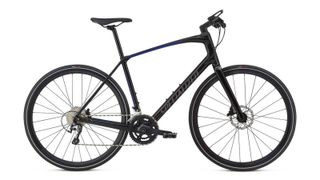 Flat Bar Road Bike
Flat Bar Road Bike
Folding Bikes
Folding bikes are designed for ultimate portability, making them an excellent choice for commuters with limited storage space or those who combine cycling with other modes of transportation. These bikes typically feature small 20-inch wheels and a frame that can be folded down to a compact size. While they may not be as fast or comfortable as other types of commuter bikes, their convenience is unmatched.
Getty Images highlights that folding bikes are perfect for navigating crowded city streets and easily stored under a desk or in a closet. Their compact design makes them ideal for commuters who need to carry their bike on trains or buses.
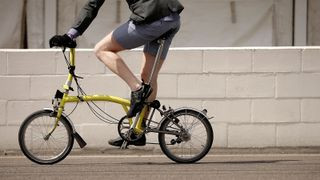 Folding Bike
Folding Bike
Hybrid Bikes
Hybrid bikes combine features from road, mountain, and touring bikes, offering a versatile option for commuters. These bikes typically have a comfortable, upright riding position, a suspension fork, and provisions for fenders and racks. Hybrid bicycles are designed to handle a variety of terrains, from smooth bike paths to rough city streets, making them a practical choice for many commuters.
Cyclingnews explains that hybrid bikes are designed for utility, often featuring belt-driven drivetrains or internally geared hubs. Their ability to handle various terrains and accommodate accessories makes them a popular choice for everyday commuting.
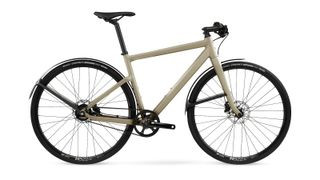 Hybrid Bike
Hybrid Bike
Touring Bikes
Touring bikes are built for long-distance riding and carrying heavy loads, making them a durable and reliable option for commuting. These bikes feature a sturdy frame, wide tires, and numerous mounting points for racks and fenders. While they may be heavier than other types of commuter bikes, their durability and comfort make them suitable for longer commutes or those who need to carry a lot of gear.
Cyclingnews notes that touring bikes are designed to cover significant distances with luggage, making them ideal for commuters who need a robust and reliable bike. The heavy-duty frame and comfortable geometry ensure a smooth and stable ride, even when fully loaded.
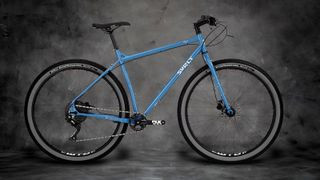 Touring Bike
Touring Bike
Road Bikes
Road bikes are designed for speed and efficiency, making them a good option for longer commutes where performance is a priority. These bikes feature a lightweight frame, drop handlebars, and narrow tires. However, they may not be as comfortable or practical as other types of commuter bikes, as they often lack provisions for fenders and racks.
Bombtrack highlights that road bikes are designed for efficiency and speed, making them suitable for commuters who want to incorporate their daily ride into their training routine. However, the lack of mounting points for accessories may limit their practicality for some commuters.
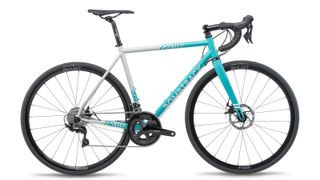 Road Bike
Road Bike
Cargo Bikes
Cargo bikes are designed for carrying heavy loads, making them an excellent choice for commuters who need to transport groceries, children, or other bulky items. These bikes come in various styles, including Dutch-style box bikes and longtail designs. Cargo bikes are available in both traditional and electric-assist models.
Cyclingnews emphasizes that cargo bikes are ideal for replacing a car, offering the ability to carry everything from groceries to passengers. Their modular mounting systems allow for customization to meet specific needs, making them a versatile option for families and businesses.
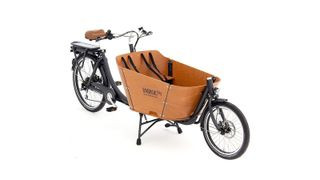 Cargo Bike
Cargo Bike
E-Bikes
E-bikes, or electric bikes, provide pedal assistance, making them an excellent choice for commuters who want to tackle hills, cover longer distances, or arrive at their destination without breaking a sweat. These bikes are equipped with a motor and battery that provide extra power when you pedal. E-bikes are available in nearly every category of bike, including flat bar road bikes, hybrid bikes, and cargo bikes.
Cyclingnews notes that e-bikes are becoming increasingly popular among commuters due to their ability to make cycling more accessible and less dependent on personal fitness. The pedal-assist feature allows riders to tackle challenging routes with ease, making them a life-changing option for many.
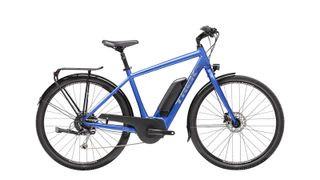 E-Bike
E-Bike
4. Factors Influencing the Choice of Commuter Bike
What are the most important factors to consider when choosing a commuter bike? Selecting the right commuter bicycle depends on several key considerations, including the length of your commute, the terrain you’ll be riding on, and the amount of gear you need to carry. Additionally, factors such as storage space, weather conditions, and personal preferences play a significant role in the decision-making process. By carefully evaluating these factors, you can choose a bike that meets your specific needs and enhances your commuting experience.
How does commute length affect bike choice?
The length of your commute is a crucial factor in determining the best type of bike for you. For shorter commutes, a folding bike or hybrid bike may be sufficient, offering convenience and versatility. For longer commutes, a flat bar road bike or e-bike may be more appropriate, providing greater efficiency and comfort. Michael Mayer, Trek’s Director of Product Marketing, suggests that road bikes are a great efficient option for longer distances, especially with some modifications like mudguards and luggage carrying capability.
How does terrain influence bike selection?
The terrain you’ll be riding on also plays a significant role in bike selection. If your commute involves hilly areas, an e-bike may be the best option, providing extra power to tackle inclines. For rough or uneven roads, a hybrid bike with a suspension fork can offer a more comfortable ride. Touring bikes are also well-suited for varied terrains, offering stability and durability.
What role does storage play in choosing a commuter bike?
Storage space is an important consideration, especially for commuters who live in apartments or have limited space at their workplace. Folding bikes are designed for easy storage, making them an ideal choice for those with space constraints. If storage is not an issue, other types of commuter bikes may be more suitable, offering greater comfort and performance. Mark Cote, the Active Category Leader at Specialized, highlights the importance of considering where you will store and park your bike, as this can influence the best setup for your needs.
5. Essential Accessories for Commuting
What accessories are essential for enhancing the safety and convenience of your commute? To maximize the safety and enjoyment of your commute, certain accessories are indispensable. These include helmets, lights, locks, fenders, racks, and panniers. Investing in high-quality accessories can significantly improve your riding experience, providing added protection, visibility, and convenience.
What are the must-have safety accessories for commuting?
Safety should always be a top priority when commuting by bike. A helmet is the most important safety accessory, protecting your head in the event of a fall. Lights are essential for visibility, especially during early morning or late evening commutes. A bright front light and a rear light can help you be seen by motorists and pedestrians. Reflective clothing and accessories can also enhance your visibility in low-light conditions. According to the Motorcycle Safety Foundation (MSF), in July 2025, wearing a helmet reduces the risk of head injury by 60%.
How can fenders and racks improve your commuting experience?
Fenders and racks are practical accessories that can significantly improve your commuting experience. Fenders protect you from rain, mud, and road spray, keeping you clean and dry in wet conditions. Racks allow you to carry your belongings with ease, whether it’s a backpack, groceries, or work documents. Panniers, which attach to racks, provide additional storage space and help distribute the weight evenly, making your ride more comfortable.
What type of lock is best for securing your commuter bike?
Securing your commuter bike with a reliable lock is essential to prevent theft. There are several types of bike locks available, each offering different levels of security. U-locks are generally considered the most secure, providing excellent protection against theft. Chain locks are also a good option, offering flexibility and strength. Cable locks are less secure but can be used to secure accessories or as a secondary lock. It’s important to choose a high-quality lock and use it properly to deter thieves. Cyclingnews offers a guide to the best bike locks to keep your bike safe.
6. Maximizing Comfort and Efficiency on Your Commute
How can you optimize your commuter bike for maximum comfort and efficiency? Optimizing your commuter bike for comfort and efficiency involves making adjustments to the bike’s fit, choosing the right tires, and maintaining the bike properly. A properly fitted bike will reduce strain and fatigue, while the right tires can improve rolling resistance and handling. Regular maintenance will ensure that your bike is running smoothly and efficiently.
How important is bike fit for commuting comfort?
Bike fit is crucial for commuting comfort. A properly fitted bike will allow you to ride in a comfortable and efficient position, reducing strain on your back, neck, and joints. It’s important to adjust the saddle height, handlebar position, and stem length to achieve the optimal fit. Many bike shops offer professional bike fitting services to help you find the perfect fit.
What tire characteristics are best for commuter bikes?
The right tires can significantly improve the performance and comfort of your commuter bike. Wider tires, typically 32c or larger, offer better stability and shock absorption on city streets. Puncture-resistant tires can help prevent flats, reducing downtime and frustration. Tires with a smooth tread pattern offer lower rolling resistance, making your ride more efficient.
How does regular maintenance improve commuting efficiency?
Regular maintenance is essential for keeping your commuter bike running smoothly and efficiently. This includes cleaning and lubricating the chain, checking brake function, inflating tires to the proper pressure, and inspecting the bike for any signs of wear or damage. A well-maintained bike will be more efficient, reliable, and enjoyable to ride. The American Motorcyclist Association (AMA) emphasizes the importance of regular maintenance to ensure a safe and efficient ride.
7. Addressing Common Commuting Challenges
What are some common challenges faced by bike commuters, and how can they be overcome? Bike commuters often face challenges such as navigating traffic, dealing with inclement weather, and finding secure bike parking. However, with proper planning and preparation, these challenges can be overcome. By choosing the right routes, using appropriate gear, and advocating for better bike infrastructure, you can make your commute safer and more enjoyable.
How can you safely navigate traffic while commuting?
Navigating traffic safely is a key concern for bike commuters. It’s important to choose routes with bike lanes or low traffic volumes whenever possible. Follow traffic laws, use hand signals to indicate turns, and be aware of your surroundings. Wear bright clothing and use lights to enhance your visibility. Ride defensively, anticipating the actions of motorists and pedestrians.
What gear is essential for commuting in inclement weather?
Commuting in inclement weather requires appropriate gear to stay comfortable and safe. Waterproof jackets, pants, and shoe covers can protect you from rain and snow. Fenders can help keep you dry and clean by preventing road spray. Gloves and hats can keep you warm in cold weather. It’s also important to adjust your riding style to account for slippery conditions, reducing your speed and increasing your following distance.
How can you find secure bike parking at your destination?
Finding secure bike parking is essential to prevent theft. Look for bike racks or lockers at your workplace, school, or other destinations. If secure parking is not available, consider bringing your bike indoors or using a high-quality lock to secure it to a sturdy object. Advocate for better bike parking infrastructure in your community by contacting local officials and businesses.
8. The Rising Popularity of E-Bikes for Commuting
Why are e-bikes becoming increasingly popular for commuting? E-bikes are gaining popularity among commuters due to their ability to make cycling more accessible and enjoyable. The pedal-assist feature allows riders to tackle hills, cover longer distances, and arrive at their destination without breaking a sweat. E-bikes offer a practical and eco-friendly alternative to cars, reducing traffic congestion and promoting physical activity.
What are the key benefits of using an e-bike for commuting?
Using an e-bike for commuting offers several key benefits. The pedal-assist feature makes it easier to tackle hills and headwinds, reducing the amount of effort required. E-bikes allow you to cover longer distances more quickly than traditional bikes, making them a practical option for longer commutes. Additionally, e-bikes can help you arrive at your destination feeling fresh and energized, without being drenched in sweat.
How do e-bikes compare to traditional bikes for commuting?
E-bikes offer several advantages over traditional bikes for commuting. The pedal-assist feature makes it easier to tackle challenging routes, allowing you to maintain a consistent speed. E-bikes can also help you carry heavier loads, making them a practical option for running errands or transporting groceries. However, e-bikes are typically more expensive than traditional bikes and require charging.
What factors should you consider when choosing an e-bike for commuting?
When choosing an e-bike for commuting, several factors should be considered. The battery range is an important consideration, as it determines how far you can ride on a single charge. The motor power also affects performance, with more powerful motors providing greater assistance on hills. The weight of the e-bike is also a factor, as heavier bikes can be more difficult to maneuver. Additionally, consider the type of e-bike, such as a flat bar road e-bike, hybrid e-bike, or cargo e-bike, to determine which best meets your needs.
9. Health and Environmental Benefits of Bike Commuting
What are the health and environmental benefits of choosing a commuter bike? Commuting by bike offers numerous health and environmental benefits. Regular cycling can improve cardiovascular health, strengthen muscles, and boost overall fitness. Bike commuting also reduces your carbon footprint, contributing to a cleaner environment. By choosing a commuter bike, you can improve your health, save money, and help protect the planet.
How does bike commuting improve physical health?
Bike commuting provides a great form of exercise, improving physical health in numerous ways. Regular cycling can strengthen your cardiovascular system, lowering your risk of heart disease, stroke, and other health problems. It can also help you maintain a healthy weight, build muscle strength, and improve your overall fitness level. A study by the University of California, Davis, found that bike commuters report higher levels of happiness and lower stress levels compared to those who drive.
What are the environmental benefits of bike commuting?
Bike commuting offers significant environmental benefits. By choosing a bike instead of a car, you can reduce your carbon footprint, helping to combat climate change. Bikes produce no emissions, contributing to cleaner air and a healthier environment. Additionally, bike commuting reduces traffic congestion, making it easier for everyone to get around.
How does bike commuting contribute to a sustainable lifestyle?
Bike commuting is a key component of a sustainable lifestyle. By choosing a bike, you can reduce your reliance on fossil fuels, conserve natural resources, and promote a healthier planet. Bike commuting also encourages a more active and engaged lifestyle, connecting you with your community and the environment. By making bike commuting a part of your daily routine, you can contribute to a more sustainable and vibrant future.
10. Joining the Biker Community through usabikers.net
How can usabikers.net help you connect with the biker community and find the best commuter bike for your needs? At usabikers.net, we are dedicated to providing you with the information, resources, and community support you need to make the most of your bike commuting experience. Whether you’re a seasoned cyclist or a beginner, our website offers a wealth of articles, reviews, and forums to help you find the perfect commuter bike, learn about essential accessories, and connect with other riders. Join our community today and discover the joys of bike commuting!
What resources does usabikers.net offer for bike commuters?
usabikers.net offers a wide range of resources for bike commuters, including detailed reviews of different types of commuter bikes, guides to essential accessories, and tips for safe and efficient commuting. Our articles cover topics such as bike maintenance, route planning, and gear selection, providing you with the knowledge you need to make informed decisions. We also offer a forum where you can connect with other bike commuters, share experiences, and ask questions.
How can you connect with other bikers through usabikers.net?
Connecting with other bikers is easy through usabikers.net. Our forum provides a platform for you to share your experiences, ask questions, and connect with riders from around the country. You can also join local biking groups and participate in events to meet other cyclists in person. Building a community of like-minded individuals can enhance your biking experience, providing support, motivation, and friendship.
What are the benefits of joining the usabikers.net community?
Joining the usabikers.net community offers numerous benefits. You’ll have access to a wealth of information and resources, helping you make informed decisions about your bike commuting journey. You’ll also have the opportunity to connect with other riders, sharing experiences, asking questions, and building friendships. Our community provides a supportive and welcoming environment for bikers of all levels, from beginners to experienced cyclists.
Ready to transform your daily commute into a healthy, enjoyable, and eco-friendly experience? Visit usabikers.net today to explore our comprehensive guides, connect with a vibrant community of bikers, and discover the perfect commuter bike for your needs. Whether you’re looking for detailed reviews, expert advice, or a place to share your passion for cycling, usabikers.net is your ultimate resource. Join us now and start your journey towards a better commute and a better lifestyle!
Address: 801 Sturgis Main St, Sturgis, SD 57785, United States
Phone: +1 (605) 347-2000
Website: usabikers.net
Frequently Asked Questions (FAQs) About Commuter Bikes
1. What is the difference between a commuter bike and a regular bike?
A commuter bike is specifically designed for daily travel to work, school, or errands, focusing on comfort, durability, and practicality with features like fenders, racks, and lights. Regular bikes are more general-purpose and may not have these specific features.
2. Is a hybrid bike a good commuter bike?
Yes, a hybrid bike is an excellent commuter bike. It combines features from road, mountain, and touring bikes, offering versatility for various terrains and comfortable, upright riding positions.
3. What is the best type of bike for a long commute?
For a long commute, a flat bar road bike or an e-bike is often the best choice. Flat bar road bikes offer efficiency and speed, while e-bikes provide pedal assistance for tackling hills and longer distances with less effort.
4. How much should I spend on a commuter bike?
The amount you should spend on a commuter bike varies depending on your needs and budget. Entry-level commuter bikes can range from $300 to $700, while higher-end models with advanced features like e-bikes can cost $1,000 or more.
5. What accessories do I need for bike commuting?
Essential accessories for bike commuting include a helmet, lights (front and rear), a reliable bike lock, fenders, and a rack or panniers for carrying belongings. Reflective clothing and a repair kit are also recommended.
6. How do I maintain a commuter bike?
Regular maintenance for a commuter bike includes cleaning and lubricating the chain, checking tire pressure, inspecting brakes, and ensuring all components are properly adjusted. A professional tune-up once or twice a year is also beneficial.
7. How do I choose the right size commuter bike?
Choosing the right size commuter bike is crucial for comfort and efficiency. Consult a bike size chart or visit a local bike shop for a professional fitting. Consider your height and inseam to determine the appropriate frame size.
8. Are e-bikes good for commuting?
Yes, e-bikes are excellent for commuting. They provide pedal assistance, making it easier to tackle hills, cover longer distances, and arrive at your destination without excessive sweating.
9. How do I secure my bike while commuting?
Secure your bike by using a high-quality U-lock or chain lock to attach the frame and wheels to a sturdy bike rack. Choose well-lit and visible parking locations to deter theft.
10. What are the health benefits of bike commuting?
Bike commuting improves cardiovascular health, strengthens muscles, helps maintain a healthy weight, and boosts overall fitness. It also reduces stress and increases mental well-being.
